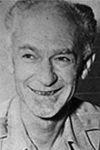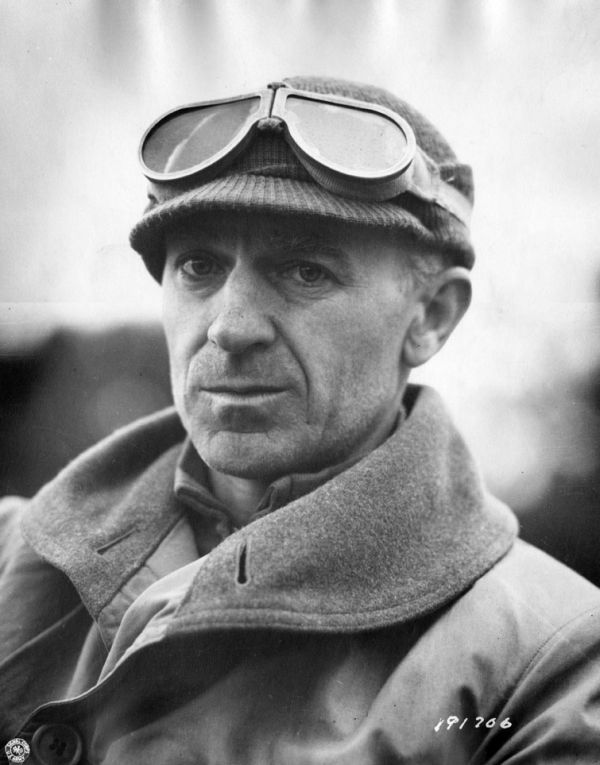G.I. Stories 1941-1945 wants to bring the story of the American soldier to a larger audience
John J. Capasso runs the Instagram account @g.i.stories41_45, which is also the name of a series of booklets published between 1942 and 1945 by the US Army magazine Stars and Stripes about the Second World War. John also posts clips on YouTube and Facebook under the same name. G.I. Stories is one of the better history accounts and it frequently uploads high-quality content about American soldiers during the Second World War. He has more than 10,000 followers and posts content daily. We’ve emailed him some questions and he was kind enough to answer them.
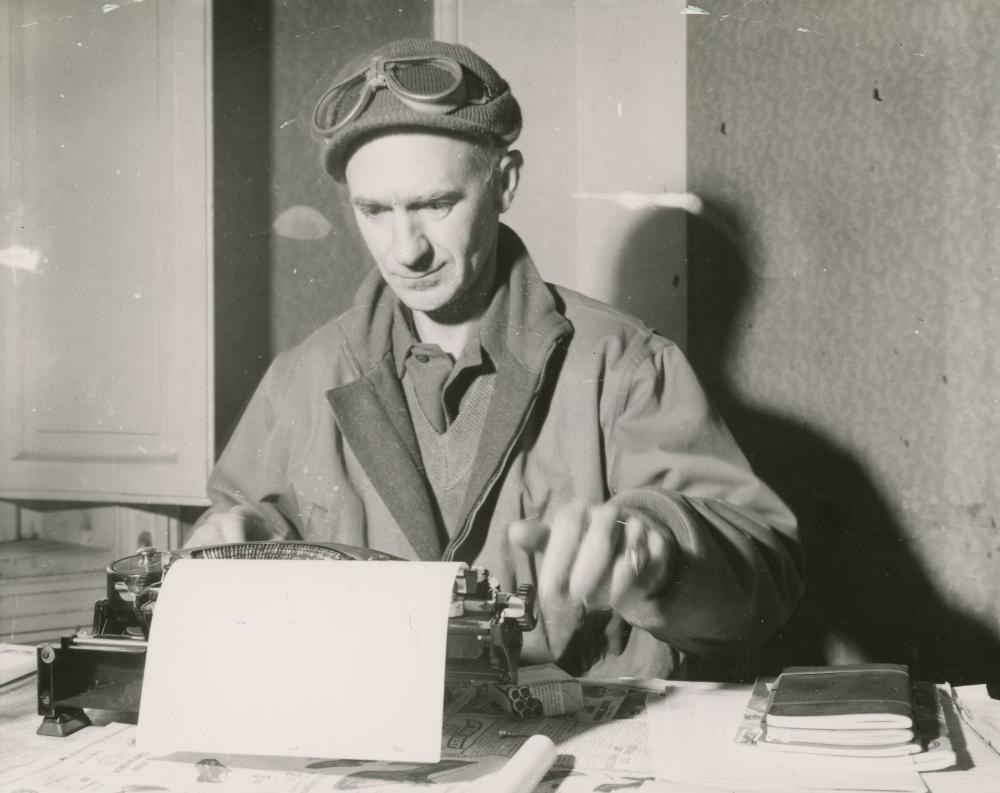 Ernie Pyle. He did more to bridge the gap between US homefront and warfront than any other writer active during WWII. Source: Naval History and Heritage Command, SC 191705
Ernie Pyle. He did more to bridge the gap between US homefront and warfront than any other writer active during WWII. Source: Naval History and Heritage Command, SC 191705
What is your connection to the Second World War? How did your interest start?
Both of my grandfathers, a few uncles, and other men I knew as family friends and in my local community served during World War II. I was always drawn to them and to their stories. My paternal grandfather, John J. Capasso, was drafted in 1942, and served as a medic in the 63rd Armored Infantry Battalion, 11th Armored Division. His unit was first engaged in late December 1944 as part of the “Battle of the Bulge.” He and his veteran friends took photos throughout their time in the service and exchanged prints after the war, so I came to learn about the European Theater through these images as a child. Before he died, my grandfather sat with me – I was probably 10 years old – and went over many of his photos. The most striking and impactful images were photos from the Mauthausen-Gusen concentration camp. It was hard to believe my grandfather had seen that horror – in addition to the horrors of the wounded and dead from combat – with his own eyes. I distinctly remember my grandfather telling me, “Don’t let people tell you this didn’t happen” in reference to Mauthausen. I took that to heart, but also applied it to the entire experience of the American soldier during the war.
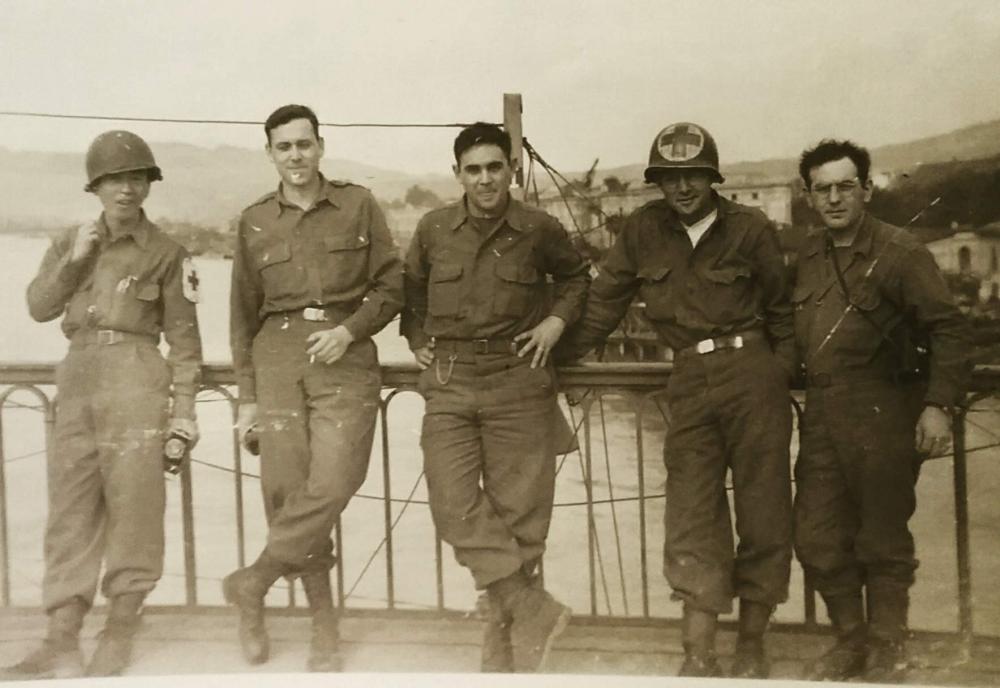 John J. Capasso (middle) was drafted in 1942, and served as a medic in the 63rd Armored Infantry Battalion, 11th Armored Division. Source: John J. Capasso
John J. Capasso (middle) was drafted in 1942, and served as a medic in the 63rd Armored Infantry Battalion, 11th Armored Division. Source: John J. Capasso
You have three different outlets: Facebook, YouTube and Instagram. When and why did you decide to start sharing World War Two history on social media?
I don’t like social media. That’s a bit odd for someone with this hobby to say, isn’t it? Let me explain: I never really like to be in the spotlight, and the concept of sharing a curated, filtered version of my life to try to impress others just isn’t my thing. I’m not judging anyone; everyone is free to do as they please and what makes them happy.
One day I thought, “what if I could use this platform to share my interests, bring the stories of these soldiers to larger audience?” Once I became a bit more tech savvy, I found other accounts with huge followings who had been posting historical content long before the idea occurred to me. It is somewhat of a niche interest, so I am amazed that it gained any traction at all in my case. I was hyper-focused on US soldiers in WWII, and I wanted all of my posts to be anchored on that specific theme.
All of this started on Instagram in 2020, and then I found out that I could cross-post everything to Facebook – which was helpful because there are different audiences on different platforms. A friend of mine who is a professional historian introduced me to NARA shortly thereafter, and that is when all the footage-posting on YouTube began. After almost five years of sharing these images, I can say that there is really no end in sight. There are still many visual and written stories about individual soldiers and units that have yet to be shared with the audience afforded by social media.
What made you decide to focus on the G.I. during the Second World War?
Even though I had the utmost respect for the service of my family members and friends, as a young man, I was very interested in the German military of WWII. It was clear they were the enemy, and I had no love for the hate-filled ideology of the NSDAP, but I think it is hard to deny they excelled at marketing and propaganda. The appearance of the uniforms, the symbology, the technology, etc. was all very fascinating to me. And, in my defense, it must have been fascinating to American soldiers, too, as they were notorious for their souvenir hunting and collecting captured items, ranging from uniform insignia to vehicles.
In the early 2000s, I attended multiple German veteran reunions in Germany. In 2008, I also spent time with a German veteran one-on-one who told me about his experiences on the Eastern Front in 1945 and as a POW in Siberia. Something hit me very hard listening to this man’s story: I knew more about his experiences than what my own grandfathers did during World War II. I was utterly embarrassed. I resolved that this would change, and I was going to put all of the German stuff on the shelf, and start looking into what my grandfathers did, where they were, what their units did, etc. I’ve never looked back.
Could you share a story that made a lasting impact on you? Is there a story that has really surprised or shocked you?
In general, the stories that have had the biggest impact on me have been from people who reached out to say, “My grandfather was in that unit,” “That’s a picture of my dad!,” and “My mother grew up in that village, and she remembers the American soldiers.” All of those things have happened multiple times over, and I am always humbled that a photo I post or story I share can have a very personal connection to someone across the country or world. Often, they will follow up with an anecdote or information on their relative who served or was in Europe during the war.
A few people have also asked me if I could help them find info relatives who were killed during the war. Back in 2021, a young woman sent me some photos of a letter dated February 13, 1945. The letter was from her great-great uncle who served in K Company, 405th Infantry Regiment, 102d Infantry Division (“Ozarks”). I found his name in the roster, Wilbur N. Freeman of Dawson, Alabama. Using the divisional history, I determined that his 3rd battalion was south of Himmerich, Germany on the Roer River, waiting for Operation Grenade (Roer Crossing) to begin in late January/early February 1945. I was able to send some information such as maps, reports, a company photo, and a roster to Freeman’s niece. I found out that Freeman was killed in action on February 16, 1945. Looking back through the photos, I realized that Wilbur had written that letter three days before he was killed, and it was postmarked February 16, the day of his death. It was addressed to his mother, Maggie. That stuck with me; I was probably looking at the last letter he ever wrote, his last connection to his parents, then he was gone at 29 years old.
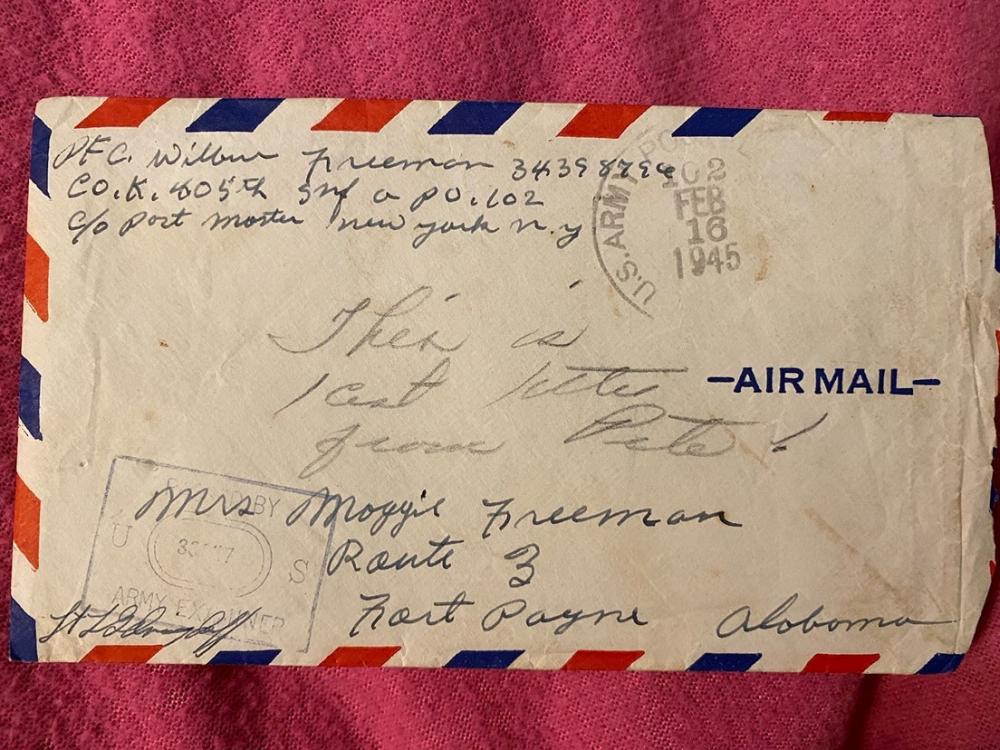 Envelope of a letter dated February 13, 1945. It contains the last letter of Wilbur N. Freeman. Source: John J. Capasso
Envelope of a letter dated February 13, 1945. It contains the last letter of Wilbur N. Freeman. Source: John J. Capasso
Do you have a favorite historical figure and who is it and why?
It is hard for me to pick just one person, as there are a myriad of people that I find important specifically in the context of US-involvement in WWII. For the focus of this interview, I’d have to pick Ernie Pyle. Reading “Brave Men” and “Here Is Your War” probably gave me the most insight into the WWII soldier from an outsider’s perspective as any biography, memoir, or unit history ever did. Pyle did more to bridge the gap between US homefront and warfront than any other writer active during WWII. He became a celebrity in his own right, and I think he is well-deserving of his status.
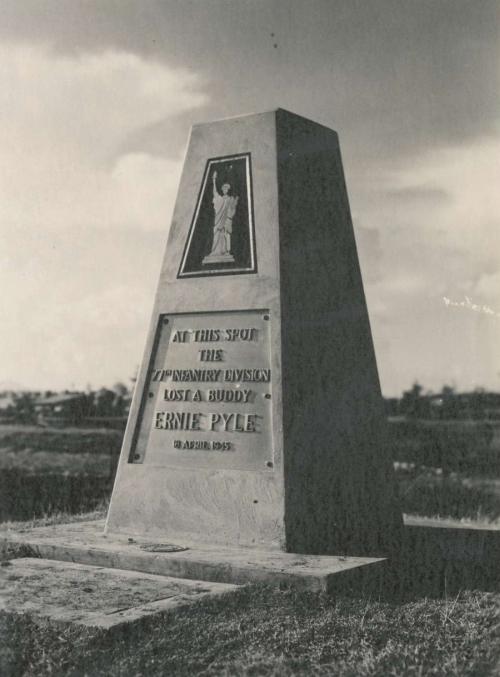 The monument erected by the 77th Infantry Division marking the site of Pyle’s demise. Source: John J. CapassoI heard the name “Ernie Pyle” many times as a kid before knowing anything about him; my maternal grandfather, Jero R. Mancuso, was in the 463rd Fighter Squadron, 507th Fighter Group, and was stationed on Iejima (then called “Ie Shima”) in late June/early July 1945. My grandfather visited the monument erected by the 77th Infantry Division marking the site of Pyle’s demise and took a photo of it. I had no idea when I saw that photo at 7-8 years old that the plaque marked “At this spot, the 77th Infantry Division lost a buddy, Ernie Pyle, 18 April, 1945” would indirectly play such a significant role in my life as an adult.
The monument erected by the 77th Infantry Division marking the site of Pyle’s demise. Source: John J. CapassoI heard the name “Ernie Pyle” many times as a kid before knowing anything about him; my maternal grandfather, Jero R. Mancuso, was in the 463rd Fighter Squadron, 507th Fighter Group, and was stationed on Iejima (then called “Ie Shima”) in late June/early July 1945. My grandfather visited the monument erected by the 77th Infantry Division marking the site of Pyle’s demise and took a photo of it. I had no idea when I saw that photo at 7-8 years old that the plaque marked “At this spot, the 77th Infantry Division lost a buddy, Ernie Pyle, 18 April, 1945” would indirectly play such a significant role in my life as an adult.
Oh, and by the way, the close second in this race is cartoonist Bill Mauldin. Willie & Joe probably taught me just as much about GIs as Pyle. I am an absolute Mauldin devotee, and I own multiple pieces of “Up Front” memorabilia, about 30 copies of his various publications (10 copies of “Up Front”), and an original sketch Mauldin did for a Lieutenant Colonel who served in the 34th Infantry Division and 88th Infantry Division on occupation duty.
You are one of the few influencers that consistently shares the sources of your content. Why do you find this important and what are your main sources?
It is important to let people know where they can find the images and footage for themselves. Citing sources is also intended to acknowledge the archivists, librarians, etc. who work tirelessly to organize and digitize the content for researchers to access and share. Besides personal photos from my grandfathers, none of these photos or videos belong to me; they belong to everyone as part of the historical record.
Original unit history books were the starting point for the venture. Mostly published between 1945-1950, collecting the original books really fanned the flame of my passion. Reading the soldier’s stories in their own words, really gives a taste for how these men thought, wrote about, and processed their own experiences. The namesake of my account is the “G.I. Stories” series of booklets printed by Stars & Stripes beginning in 1945 to provide soldiers with something brief documenting their own division’s history. US soldiers were writing their own story, and I try to give that aspect a voice, even when every German tank is a “Tiger” and every piece of German artillery is an “88.”
Other content comes from the US National Archives, Digital Collections of the National WWII Museum, the United States Holocaust Memorial Museum, and other various collections stored digitally by universities around the US.
What do you hope your followers learn from your posts?
In the US Army, the majority of soldiers were draftees. They were called up to do a job they likely didn’t want to do, nor did they exactly understand why it had to be done. Men and women from all reaches of the United States, many different races, religions, socio-economic backgrounds came together for a common purpose. They went above and beyond what was expected of them, putting their lives in jeopardy to serve the greater good. From the “dogface” in a foxhole to the supply clerk in the States, they did their part to help the war effort. This story deserves to be told on every level and from every perspective. It should guide us as a society. These stories remind me to dig a little deeper on days where I feel burnt out, because my hardest day is nothing compared to what these men and women endured – this even includes civilians on the homefront.
War is hell. It isn’t glamorous, it isn’t a clean business, and people who had nothing to do with starting them usually have to fight them.
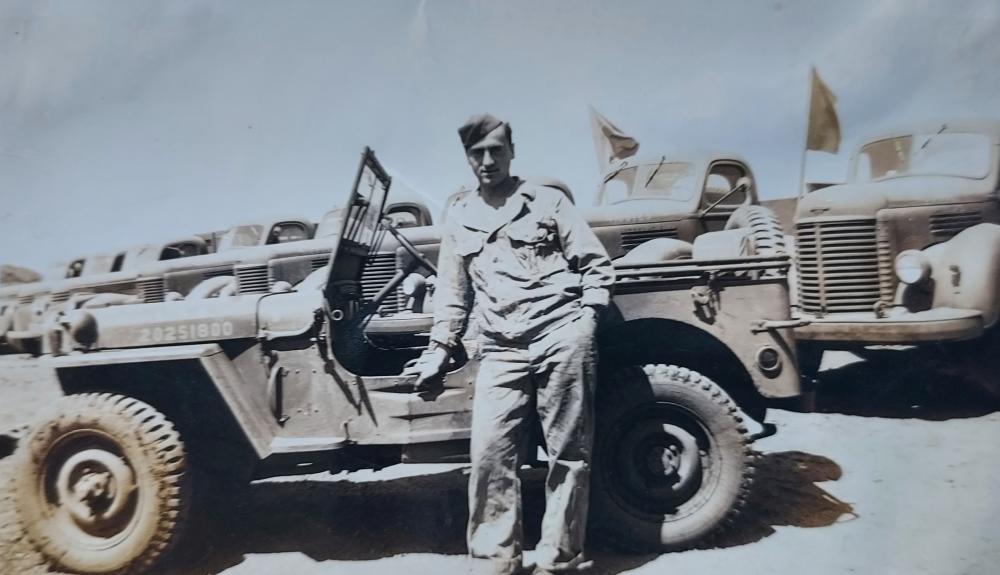 Jero R. Mancuso. He was in the 463rd Fighter Squadron, 507th Fighter Group, and was stationed on Iejima (then called "Ie Shima") in late June/early July 1945. Source: John J. Capasso
Jero R. Mancuso. He was in the 463rd Fighter Squadron, 507th Fighter Group, and was stationed on Iejima (then called "Ie Shima") in late June/early July 1945. Source: John J. Capasso
What are your plans for the future in relation to your interest in the Second World War?
I’ve been able to put together some interesting stories that include original wartime interviews, photos, and video. I will either need to up my editing game or find a partner to help me put those together. One of those stories involves an unnamed Tank Destroyer gunner who was responsible for knocking out multiple German tanks in a single engagement in November 1944. I put together his whole story, now I just need an outlet/proper format to share it. (Any takers?) Besides that, I will continue what I have been doing: finding photos and footage. Curating and editing it to highlight specific US units at specific places and dates will continue to be my focus. I’m always willing to look for photos, footage, and information for others who are interested, so don’t hesitate to email or send a message on Instagram.
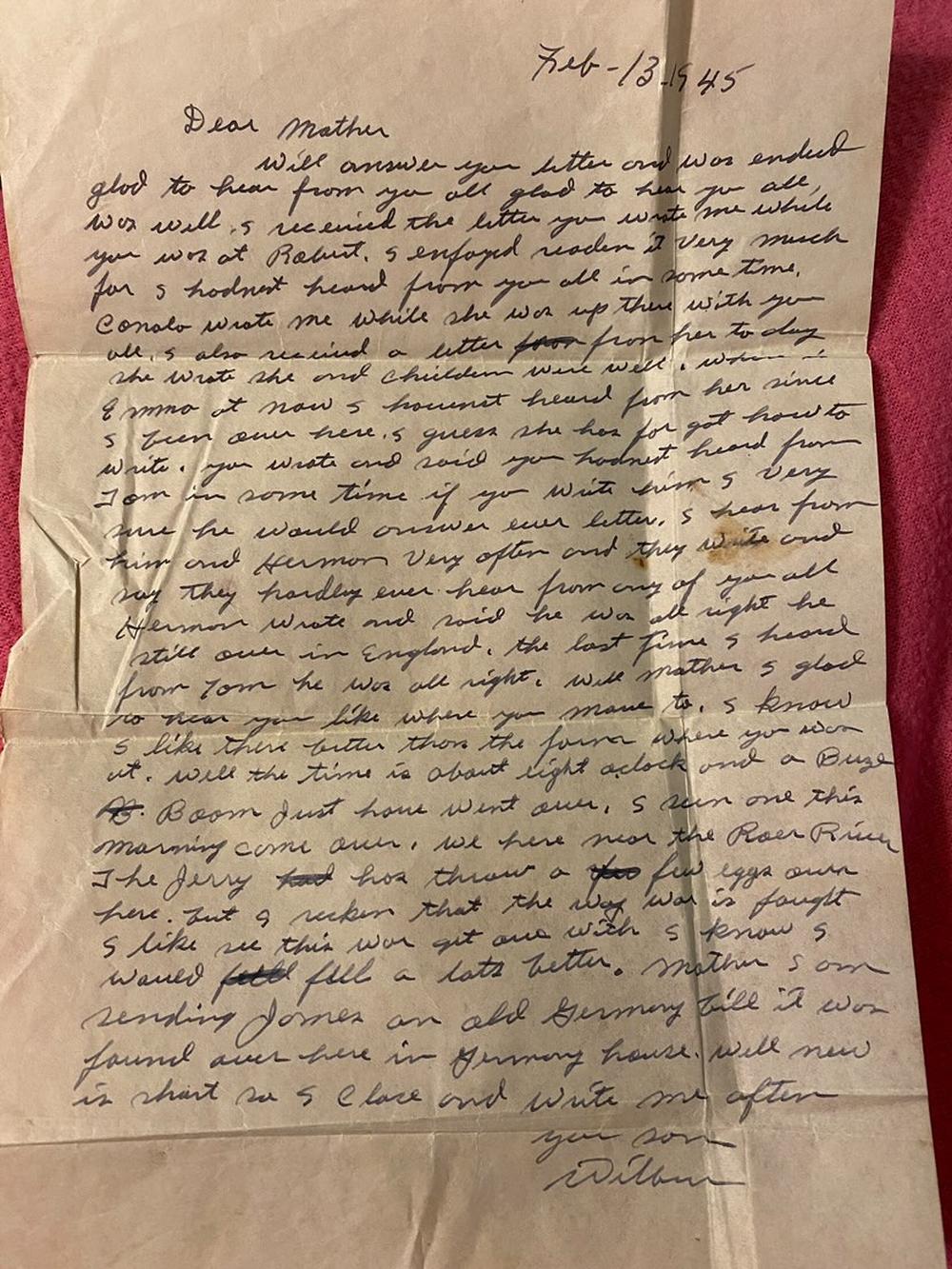 The last letter of Wilbur N. Freeman. Source: John J. Capasso
The last letter of Wilbur N. Freeman. Source: John J. Capasso
 Ernie Pyle. He did more to bridge the gap between US homefront and warfront than any other writer active during WWII. Source: Naval History and Heritage Command, SC 191705
Ernie Pyle. He did more to bridge the gap between US homefront and warfront than any other writer active during WWII. Source: Naval History and Heritage Command, SC 191705What is your connection to the Second World War? How did your interest start?
Both of my grandfathers, a few uncles, and other men I knew as family friends and in my local community served during World War II. I was always drawn to them and to their stories. My paternal grandfather, John J. Capasso, was drafted in 1942, and served as a medic in the 63rd Armored Infantry Battalion, 11th Armored Division. His unit was first engaged in late December 1944 as part of the “Battle of the Bulge.” He and his veteran friends took photos throughout their time in the service and exchanged prints after the war, so I came to learn about the European Theater through these images as a child. Before he died, my grandfather sat with me – I was probably 10 years old – and went over many of his photos. The most striking and impactful images were photos from the Mauthausen-Gusen concentration camp. It was hard to believe my grandfather had seen that horror – in addition to the horrors of the wounded and dead from combat – with his own eyes. I distinctly remember my grandfather telling me, “Don’t let people tell you this didn’t happen” in reference to Mauthausen. I took that to heart, but also applied it to the entire experience of the American soldier during the war.
 John J. Capasso (middle) was drafted in 1942, and served as a medic in the 63rd Armored Infantry Battalion, 11th Armored Division. Source: John J. Capasso
John J. Capasso (middle) was drafted in 1942, and served as a medic in the 63rd Armored Infantry Battalion, 11th Armored Division. Source: John J. CapassoYou have three different outlets: Facebook, YouTube and Instagram. When and why did you decide to start sharing World War Two history on social media?
I don’t like social media. That’s a bit odd for someone with this hobby to say, isn’t it? Let me explain: I never really like to be in the spotlight, and the concept of sharing a curated, filtered version of my life to try to impress others just isn’t my thing. I’m not judging anyone; everyone is free to do as they please and what makes them happy.
One day I thought, “what if I could use this platform to share my interests, bring the stories of these soldiers to larger audience?” Once I became a bit more tech savvy, I found other accounts with huge followings who had been posting historical content long before the idea occurred to me. It is somewhat of a niche interest, so I am amazed that it gained any traction at all in my case. I was hyper-focused on US soldiers in WWII, and I wanted all of my posts to be anchored on that specific theme.
All of this started on Instagram in 2020, and then I found out that I could cross-post everything to Facebook – which was helpful because there are different audiences on different platforms. A friend of mine who is a professional historian introduced me to NARA shortly thereafter, and that is when all the footage-posting on YouTube began. After almost five years of sharing these images, I can say that there is really no end in sight. There are still many visual and written stories about individual soldiers and units that have yet to be shared with the audience afforded by social media.
What made you decide to focus on the G.I. during the Second World War?
Even though I had the utmost respect for the service of my family members and friends, as a young man, I was very interested in the German military of WWII. It was clear they were the enemy, and I had no love for the hate-filled ideology of the NSDAP, but I think it is hard to deny they excelled at marketing and propaganda. The appearance of the uniforms, the symbology, the technology, etc. was all very fascinating to me. And, in my defense, it must have been fascinating to American soldiers, too, as they were notorious for their souvenir hunting and collecting captured items, ranging from uniform insignia to vehicles.
In the early 2000s, I attended multiple German veteran reunions in Germany. In 2008, I also spent time with a German veteran one-on-one who told me about his experiences on the Eastern Front in 1945 and as a POW in Siberia. Something hit me very hard listening to this man’s story: I knew more about his experiences than what my own grandfathers did during World War II. I was utterly embarrassed. I resolved that this would change, and I was going to put all of the German stuff on the shelf, and start looking into what my grandfathers did, where they were, what their units did, etc. I’ve never looked back.
Could you share a story that made a lasting impact on you? Is there a story that has really surprised or shocked you?
In general, the stories that have had the biggest impact on me have been from people who reached out to say, “My grandfather was in that unit,” “That’s a picture of my dad!,” and “My mother grew up in that village, and she remembers the American soldiers.” All of those things have happened multiple times over, and I am always humbled that a photo I post or story I share can have a very personal connection to someone across the country or world. Often, they will follow up with an anecdote or information on their relative who served or was in Europe during the war.
A few people have also asked me if I could help them find info relatives who were killed during the war. Back in 2021, a young woman sent me some photos of a letter dated February 13, 1945. The letter was from her great-great uncle who served in K Company, 405th Infantry Regiment, 102d Infantry Division (“Ozarks”). I found his name in the roster, Wilbur N. Freeman of Dawson, Alabama. Using the divisional history, I determined that his 3rd battalion was south of Himmerich, Germany on the Roer River, waiting for Operation Grenade (Roer Crossing) to begin in late January/early February 1945. I was able to send some information such as maps, reports, a company photo, and a roster to Freeman’s niece. I found out that Freeman was killed in action on February 16, 1945. Looking back through the photos, I realized that Wilbur had written that letter three days before he was killed, and it was postmarked February 16, the day of his death. It was addressed to his mother, Maggie. That stuck with me; I was probably looking at the last letter he ever wrote, his last connection to his parents, then he was gone at 29 years old.
 Envelope of a letter dated February 13, 1945. It contains the last letter of Wilbur N. Freeman. Source: John J. Capasso
Envelope of a letter dated February 13, 1945. It contains the last letter of Wilbur N. Freeman. Source: John J. CapassoDo you have a favorite historical figure and who is it and why?
It is hard for me to pick just one person, as there are a myriad of people that I find important specifically in the context of US-involvement in WWII. For the focus of this interview, I’d have to pick Ernie Pyle. Reading “Brave Men” and “Here Is Your War” probably gave me the most insight into the WWII soldier from an outsider’s perspective as any biography, memoir, or unit history ever did. Pyle did more to bridge the gap between US homefront and warfront than any other writer active during WWII. He became a celebrity in his own right, and I think he is well-deserving of his status.
 The monument erected by the 77th Infantry Division marking the site of Pyle’s demise. Source: John J. Capasso
The monument erected by the 77th Infantry Division marking the site of Pyle’s demise. Source: John J. CapassoOh, and by the way, the close second in this race is cartoonist Bill Mauldin. Willie & Joe probably taught me just as much about GIs as Pyle. I am an absolute Mauldin devotee, and I own multiple pieces of “Up Front” memorabilia, about 30 copies of his various publications (10 copies of “Up Front”), and an original sketch Mauldin did for a Lieutenant Colonel who served in the 34th Infantry Division and 88th Infantry Division on occupation duty.
You are one of the few influencers that consistently shares the sources of your content. Why do you find this important and what are your main sources?
It is important to let people know where they can find the images and footage for themselves. Citing sources is also intended to acknowledge the archivists, librarians, etc. who work tirelessly to organize and digitize the content for researchers to access and share. Besides personal photos from my grandfathers, none of these photos or videos belong to me; they belong to everyone as part of the historical record.
Original unit history books were the starting point for the venture. Mostly published between 1945-1950, collecting the original books really fanned the flame of my passion. Reading the soldier’s stories in their own words, really gives a taste for how these men thought, wrote about, and processed their own experiences. The namesake of my account is the “G.I. Stories” series of booklets printed by Stars & Stripes beginning in 1945 to provide soldiers with something brief documenting their own division’s history. US soldiers were writing their own story, and I try to give that aspect a voice, even when every German tank is a “Tiger” and every piece of German artillery is an “88.”
Other content comes from the US National Archives, Digital Collections of the National WWII Museum, the United States Holocaust Memorial Museum, and other various collections stored digitally by universities around the US.
What do you hope your followers learn from your posts?
In the US Army, the majority of soldiers were draftees. They were called up to do a job they likely didn’t want to do, nor did they exactly understand why it had to be done. Men and women from all reaches of the United States, many different races, religions, socio-economic backgrounds came together for a common purpose. They went above and beyond what was expected of them, putting their lives in jeopardy to serve the greater good. From the “dogface” in a foxhole to the supply clerk in the States, they did their part to help the war effort. This story deserves to be told on every level and from every perspective. It should guide us as a society. These stories remind me to dig a little deeper on days where I feel burnt out, because my hardest day is nothing compared to what these men and women endured – this even includes civilians on the homefront.
War is hell. It isn’t glamorous, it isn’t a clean business, and people who had nothing to do with starting them usually have to fight them.
 Jero R. Mancuso. He was in the 463rd Fighter Squadron, 507th Fighter Group, and was stationed on Iejima (then called "Ie Shima") in late June/early July 1945. Source: John J. Capasso
Jero R. Mancuso. He was in the 463rd Fighter Squadron, 507th Fighter Group, and was stationed on Iejima (then called "Ie Shima") in late June/early July 1945. Source: John J. CapassoWhat are your plans for the future in relation to your interest in the Second World War?
I’ve been able to put together some interesting stories that include original wartime interviews, photos, and video. I will either need to up my editing game or find a partner to help me put those together. One of those stories involves an unnamed Tank Destroyer gunner who was responsible for knocking out multiple German tanks in a single engagement in November 1944. I put together his whole story, now I just need an outlet/proper format to share it. (Any takers?) Besides that, I will continue what I have been doing: finding photos and footage. Curating and editing it to highlight specific US units at specific places and dates will continue to be my focus. I’m always willing to look for photos, footage, and information for others who are interested, so don’t hesitate to email or send a message on Instagram.
 The last letter of Wilbur N. Freeman. Source: John J. Capasso
The last letter of Wilbur N. Freeman. Source: John J. CapassoUsed source(s)
- Source: John J. Capasso / Samuel de Korte
- Published on: 25-02-2024 14:53:39
Related persons
Background stories
Related news
- 11-'24: Postal artifacts provide a vibrant testament to the experiences of the Dutch people during WWII
- 10-'24: DigitalBattlefieldTours unlocks military tactics to a wide audience
- 08-'24: Researching his father’s WWII history became a passion for Steve Snyder
- 08-'24: Who was the owner of the photo album from Dachau?
- 07-'24: The British people welcomed African American servicemen with open arms
Latest news
- 03-03: A WWII helmet returns home 80 years after having been lost at Remagen Bridge, Germany
- 16-02: Armin T. Wegner and his letter to Hitler
- 14-02: The hugely popular ‘Standing with Giants’ installation returns to the British Normandy Memorial
- 27-01: Russia focuses on Soviet victims of WW2 as officials not invited to Auschwitz ceremony
- 27-01: Oswald Kaduk, ‘Papa Kaduk’ or a monster??
- 12-'24: Christmas and New Year message from our volunteers
- 11-'24: New book: Righteous Behind Barbed Wire
- 11-'24: Postal artifacts provide a vibrant testament to the experiences of the Dutch people during WWII
- 10-'24: DigitalBattlefieldTours unlocks military tactics to a wide audience
- 10-'24: Lily Ebert, Holocaust Survivor, Author and TikTok Star, Dies at 100
